This article was co-authored by Luba Lee, FNP-BC, MS. Luba Lee, FNP-BC is a Board-Certified Family Nurse Practitioner (FNP) and educator in Tennessee with over a decade of clinical experience. Luba has certifications in Pediatric Advanced Life Support (PALS), Emergency Medicine, Advanced Cardiac Life Support (ACLS), Team Building, and Critical Care Nursing. She received her Master of Science in Nursing (MSN) from the University of Tennessee in 2006.
wikiHow marks an article as reader-approved once it receives enough positive feedback. This article has 13 testimonials from our readers, earning it our reader-approved status.
This article has been viewed 621,582 times.
Applying clean adhesive bandages (Band-Aids™) is an important part of hygienic wound care for minor cuts and scrapes. Removing the bandage, however, is not always a pleasant process. Don't skip applying a bandage to avoid the pain of removing one, however. Instead, try one of several methods to make removing a bandage less painful (or even painless).
Steps
Weakening Bandage Adhesive
-
1Soak the bandage in water. You've probably had the misfortune of coming across someone's used bandage floating in the gutter of a public swimming pool, and therefore are aware that exposure to water weakens a bandage's adhesion to skin.
- No, don't go to your public pool. Soak in the bathtub for a bit, and then try removing the bandage. A leisurely shower may work as well.
- You can also just apply a wet compress (such as a clean rag soaked in warm water) to the bandage and wait for it to soak through.[1]
- Taking a 15- to 20-minute bubble bath can help loosen the adhesive as well and it can be especially useful for kids.
-
2Use oils, soaps, creams, or lotions to weaken and lubricate the adhesive. People swear by different products -- olive oil, petroleum jelly, baby shampoo, or baby oil, to name a few -- but the process is similar regardless. Try different variations and see what works best for you and your family.
- Use a cotton ball, cotton swab, or just your finger to massage the product into the adhesive areas of the bandage. Work it in and allow it to saturate those areas of the bandage.
- Peel a corner of the bandage up to see if the adhesion has been weakened. If not, keep working in the oil or soap.
- If so, peel away the rest of the bandage in a quick motion. Use your other hand to gently press the surrounding skin down, if necessary.
- One tip for kids is adding food coloring to baby oil so that you can “paint” the mixture onto the bandage with cotton swabs. Make it a fun experience instead of a worrisome one.[2]
Advertisement -
3Lubricate extra-sticky bandages even more. Instead of yanking off a stubbornly-stuck bandage quickly, weaken the adhesive as mentioned in the last step, peel up a corner, then apply moisturizing lotion to the contact point between skin and bandage as you continue to slowly pull it away.[3]
-
4Dissolve the adhesive with alcohol. You can also use the lubricating technique with rubbing alcohol. The adhesive should slowly but surely dissolve, and any adhesive remaining on the skin can be rubbed away with the saturated cotton ball or swab.
- There are also adhesive removal products marketed for bandage removal. Check medical or surgical supply stores if not available at your drugstore.[4]
Applying Bandages Properly
-
1Don't avoid removing a bandage by not using one. One of those bits of “old-time” wisdom that still circulates today is the idea that it is better to clean a small cut, then let it “air out” and scab over. Like putting butter on a burn or tilting your head back during a nosebleed, however, this is false.
- Small wounds actually heal better in a moist environment, in which blood vessels regenerate faster and inflammation-causing cells multiply more slowly. So, preventing scab formation actually aids the healing process.[5]
- It may be no surprise that the company behind Band-Aids promotes covering cuts and scrapes instead of airing them out, but they have science on their side.[6]
-
2Prepare wounds properly for bandaging. Sometimes the worst part of pulling away a bandage is not the sticky adhesive, but dried blood / scabbing that pulls away with the bandage and reopens the wound. Proper preparation can make this less likely.[7]
- Stop the bleeding of a minor cut or scrape by applying pressure with gauze, a paper towel, a clean cloth, etc. Apply gentle pressure for up to 15 minutes, until all bleeding has stopped.
- For a large cut or wound, an excessively dirty wound, or a wound that won't stop bleeding, get medical help.
- Rinse the area with clean water and gently clean the wound with soap and water. Rinse again and pat dry with a clean cloth, etc. Don't use hydrogen peroxide or one of those old wound cleaners your grandfather swore by -- just plain old soap and water. Hydrogen peroxide and iodine can irritate an injury.
-
3Consider moistening the wound to inhibit sticking. Antibiotic ointments have shown little evidence in helping wounds heal faster, but they do help keep the wound moist and make sticking less likely upon bandage removal.[8]
- That said, plain old petroleum jelly will provide the same moistening / lubricating benefit.[9]
- Apply a small dab only over the wound itself, so the bandage will stick where it should.
-
4Cover the wound with a bandage.[10] Choose a bandage that is large enough so that the pad (the part that isn't sticky) covers the entire wound with a little room to spare. Try not to touch the pad when applying to reduce infection chances.
- Especially when wrapping a bandage around a finger (or a larger bandage wrap around an arm or leg), make it tight enough to stay in place and prevent a gap between pad and wound, but not so tight that it hampers blood flow. If your finger tingles or turns purple-ish, it's too tight.
- Apply a new bandage if the old one gets dirty or saturated with water.
-
5Get out your razor, if necessary. If you need to apply a bandage to a hairy area -- for a man, an arm or leg, or even chest or back -- you may want to prevent the inevitable pain of the bandage being stuck to your hair by removing the hair first.
- Use warm water, a fresh, clean razor, and don't shave over the wound itself.
- Unless you want to have patchy hairless spots along with your small scars, you probably should try the other bandage removal procedures discussed in this article before resorting to this step.
-
6Have faith in medical science. Bandage removal is not just an annoyance -- some 1.5 million people in the U.S. annually, mostly infants and the elderly with sensitive skin, suffer scarring or irritation from bandage removal. However, new bandages are being developed that sandwich a “quick-release” layer between the backing and dissolvable adhesive.[11]
- So, perhaps painful bandage removals will be a thing of the past soon.
Expert Q&A
-
QuestionWhat about removing Band-Aids in a sterile way?
 Jonas DeMuro, MDDr. DeMuro is a board certified Pediatric Critical Care Surgeon in New York. He received his MD from Stony Brook University School of Medicine in 1996. He completed his fellowship in Surgical Critical Care at North Shore-Long Island Jewish Health System and was a previous American College of Surgeons (ACS) Fellow.
Jonas DeMuro, MDDr. DeMuro is a board certified Pediatric Critical Care Surgeon in New York. He received his MD from Stony Brook University School of Medicine in 1996. He completed his fellowship in Surgical Critical Care at North Shore-Long Island Jewish Health System and was a previous American College of Surgeons (ACS) Fellow.
Board Certified Critical Care Surgeon Band-Aids come in sterile packaging, but they do not need to be removed in a sterile fashion. Hands should be washed and clean before removing your own Band-Aid. Protective gloves, but not sterile ones, should be worn for removing another person's Band-Aid to avoid transmission of disease, with hand-washing before and after the gloves.
Band-Aids come in sterile packaging, but they do not need to be removed in a sterile fashion. Hands should be washed and clean before removing your own Band-Aid. Protective gloves, but not sterile ones, should be worn for removing another person's Band-Aid to avoid transmission of disease, with hand-washing before and after the gloves.
References
- ↑ http://www.ebnurse.org/index.php?id=58
- ↑ http://articles.sun-sentinel.com/1994-04-26/lifestyle/9404250234_1_bandage-child-s-skin-parent-traps
- ↑ http://articles.sun-sentinel.com/1994-04-26/lifestyle/9404250234_1_bandage-child-s-skin-parent-traps
- ↑ http://articles.sun-sentinel.com/1994-04-26/lifestyle/9404250234_1_bandage-child-s-skin-parent-traps
- ↑ http://www.nytimes.com/2006/08/01/health/01real.html?_r=0
- ↑ http://www.band-aid.com/proper-wound-care/wound-care-myths
- ↑ http://www.emedicinehealth.com/care_for_a_skin_wound-health/article_em.htm
- ↑ http://www.emedicinehealth.com/care_for_a_skin_wound-health/article_em.htm
- ↑ http://www.nytimes.com/2006/08/01/health/01real.html?_r=0
About This Article
The simplest way to remove a Band Aid painlessly is to soak it in water until the adhesive weakens and you can pull it off easily. If that doesn’t work, use soap or an oil like olive oil to loosen it. Simply rub some on with your finger and allow it to saturate the bandage. Then, peel up a corner of the bandage to see if it is loose. If it is, rip it off quickly. If not, keep massaging the oil in. To learn how to dissolve the adhesive with rubbing alcohol, and how to prevent bandages from sticking in the first place, keep reading!
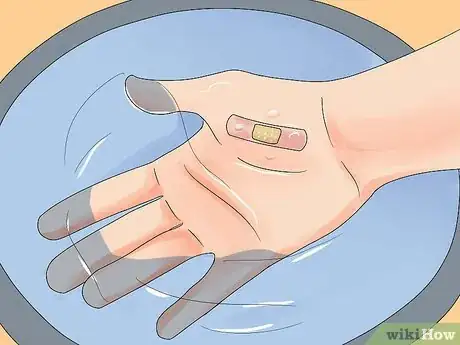
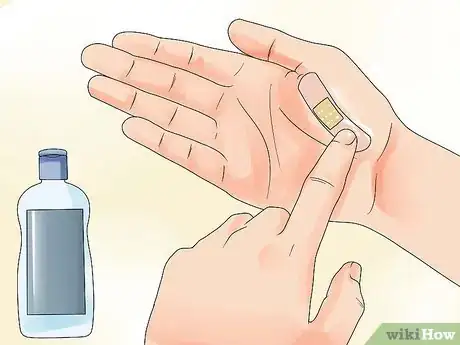
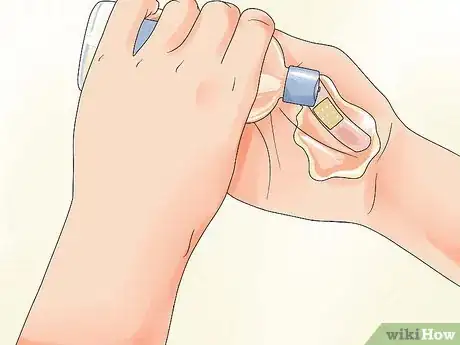

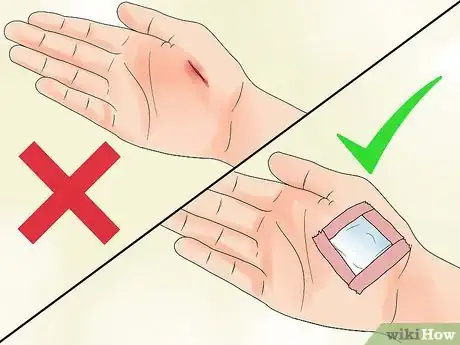
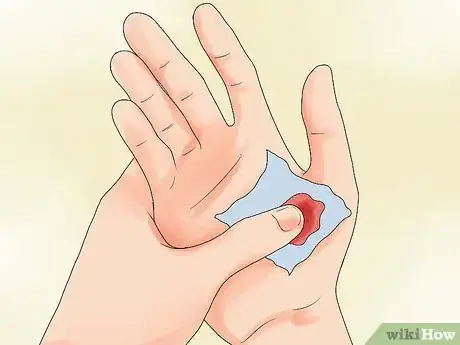
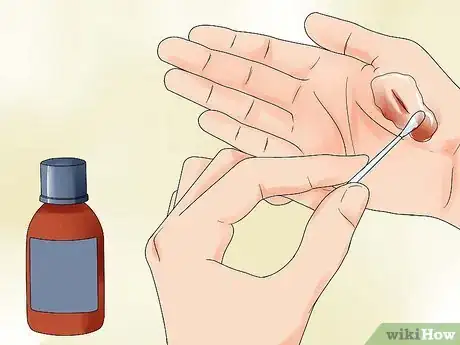
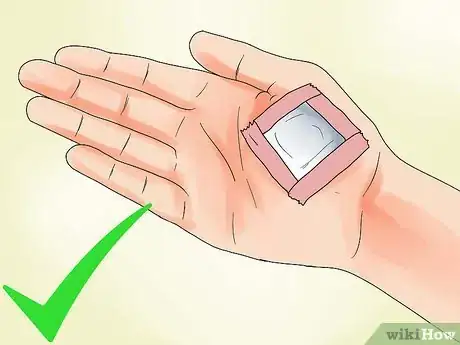

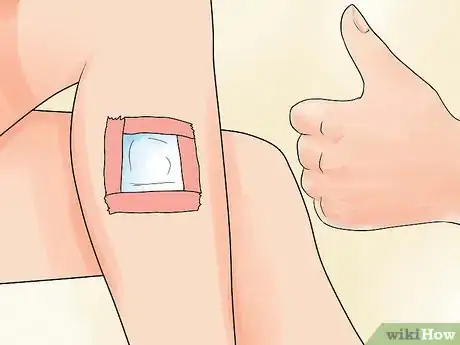
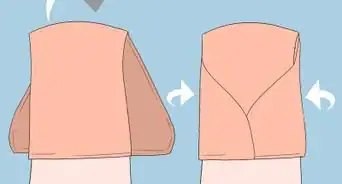



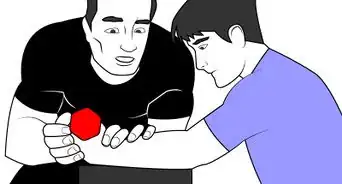
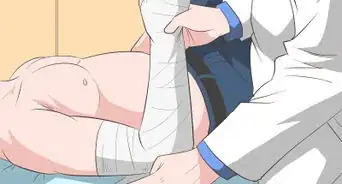
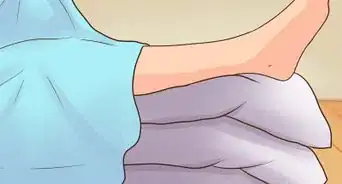


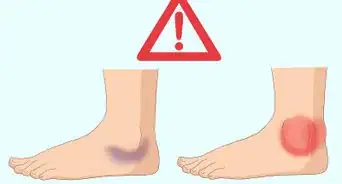
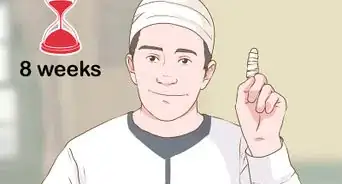

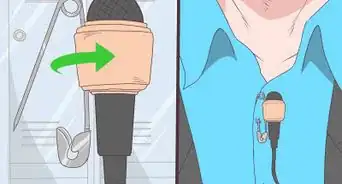











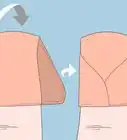
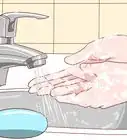

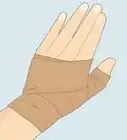



































Medical Disclaimer
The content of this article is not intended to be a substitute for professional medical advice, examination, diagnosis, or treatment. You should always contact your doctor or other qualified healthcare professional before starting, changing, or stopping any kind of health treatment.
Read More...